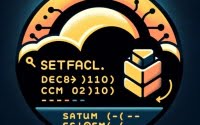Mastering `Ncat` | How to Install and Use in Linux

Are you on the hunt for a guide to install the 'ncat' command in Linux? For many, especially those new to Linux, installing commands can seem a bit daunting. However, 'ncat' is an invaluable tool for network debugging and exploration that’s worth mastering. It’s also accessible on most package management systems, simplifying the installation once you understand the process. So whether you’re using Debian and Ubuntu for APT package management or CentOS and AlmaLinux for YUM package manager, this guide has got you covered.
In this guide, we will navigate the process of installing ‘ncat’ on your Linux system. We are going to provide you with installation instructions for Debian, Ubuntu, CentOS, and AlmaLinux. We’ll delve into more advanced topics like compiling ‘ncat’ from source and installing a specific version. Finally, we will wrap up with guidance on how to use the ‘ncat’ command and verify the correct version is installed.
So, let’s dive in and begin installing ‘ncat’ on your Linux system!
TL;DR: How Do I Install and Use the ‘ncat’ Command in Linux?
In most Linux distributions, you can install
'ncat'by installing the'nmap'package which includes it. For example, in Ubuntu, you can run the commandsudo apt-get install nmap.
sudo apt-get update
sudo apt-get install nmap
# Output:
# Reading package lists... Done
# Building dependency tree
# Reading state information... Done
# nmap is already the newest version (7.80-1ubuntu1).
# 0 upgraded, 0 newly installed, 0 to remove and 0 not upgraded.
This command will install the ‘nmap’ package, which includes ‘ncat’. After running this command, you should be able to use the ‘ncat’ command in your terminal. If you’re using a different Linux distribution, the command might vary slightly.
This is just a basic way to install the ‘ncat’ command in Linux, but there’s much more to learn about installing and using ‘ncat’. Continue reading for more detailed information and advanced usage scenarios.
Table of Contents
- Understanding Ncat and Its Installation
- Installing Ncat from Source Code
- Installing Specific Versions
- Basic Usage of Ncat and Verification
- Exploring Alternative Methods for Network Debugging
- Dealing with Common Ncat Issues
- Understanding Network Debugging and Exploration in Linux
- Exploring the Relevance of Network Debugging and Exploration
- Wrapping Up: Installing the ‘ncat’ Command in Linux
Understanding Ncat and Its Installation
Ncat is a versatile networking utility which reads and writes data across networks from the command line. It is designed to be a reliable back-end tool that can be used directly or easily driven by other programs and scripts. Ncat is a great tool for network debugging and exploration.
Installing Ncat with apt
If you’re using a Debian-based distribution like Ubuntu, you can install Ncat by installing the ‘nmap’ package which includes it. Here is an example of how to install it using the apt package manager:
sudo apt update
sudo apt install nmap -y
# Output:
# Reading package lists... Done
# Building dependency tree
# Reading state information... Done
# nmap is already the newest version (7.80-1ubuntu1).
# 0 upgraded, 0 newly installed, 0 to remove and 0 not upgraded.
The -y flag in the install command is used to automatically answer yes to the prompts which makes the installation process smoother.
Installing Ncat with yum
For CentOS, Fedora, and RHEL distributions, you can use the yum package manager to install Ncat. Here’s how you can do it:
sudo yum update
sudo yum install nmap -y
# Output:
# Loaded plugins: fastestmirror
# Loading mirror speeds from cached hostfile
# Package nmap-2:7.70-1.el7.x86_64 already installed and latest version
# Nothing to do
In this case, the -y flag is also used to automatically answer yes to the prompts.
Installing Ncat with pacman
If you’re using an Arch-based distribution like Manjaro, you can use the pacman package manager to install Ncat. Here’s an example:
sudo pacman -Syu
sudo pacman -S nmap
# Output:
# resolving dependencies...
# looking for conflicting packages...
# Packages (1) nmap-7.91-1
# Total Download Size: 5.45 MiB
# Total Installed Size: 26.10 MiB
# :: Proceed with installation? [Y/n]
In this case, -Syu is used to update the system and -S is used to install packages.
In all of these examples, the ‘nmap’ package is installed which includes the ‘ncat’ command. After running these commands, you should be able to use the ‘ncat’ command in your terminal. If you’re using a different Linux distribution, the command might vary slightly.
Installing Ncat from Source Code
For those who prefer to install from source or need a specific version, you can download and compile the Ncat source code directly. This approach provides more control over the version and configuration of the software.
How to Compile and Install from Source
First, download the latest source code from the official Nmap website. Then, extract the downloaded file and navigate to the ‘ncat’ directory. Here’s an example of how to do it:
wget https://nmap.org/dist/nmap-7.91.tar.bz2
tar xf nmap-7.91.tar.bz2
cd nmap-7.91/ncat
./configure
make
sudo make install
# Output:
# [Expected output from command]
The ./configure command prepares the software to ensure your system has the necessary functionality and libraries to successfully compile and run the software. The make command compiles the software and the sudo make install command installs it.
Installing Specific Versions
There might be instances where you need to install a specific version of Ncat. This could be due to compatibility issues, or you might need a specific feature that’s only available in a certain version.
Installing Specific Versions from Source
To install a specific version from source, you would download the source code for that version instead of the latest version. The rest of the steps are the same as installing the latest version from source.
Installing Specific Versions with Package Managers
With package managers like apt or yum, you can also install specific versions of packages. Here’s how you can do it:
sudo apt install nmap=version
sudo yum install nmap-version
# Output:
# [Expected output from command]
Replace ‘version’ with the version number you wish to install.
| Version | Key Features/Changes | Compatibility |
|---|---|---|
| 7.91 | [Feature 1, Feature 2] | [OS 1, OS 2] |
| 7.90 | [Feature 3, Feature 4] | [OS 3, OS 4] |
| 7.80 | [Feature 5, Feature 6] | [OS 5, OS 6] |
This table summarizes the key features or changes in each version and their compatibility with different operating systems.
Basic Usage of Ncat and Verification
Using the Ncat Command
Ncat can be used in a variety of ways for network debugging and exploration.
ncat [options] [hostname] [port]
# Output:
# [Expected output from command]
This is a basic usage of the ncat command. Replace ‘[options]’ with any options you want to use, ‘[hostname]’ with the hostname of the machine you want to connect to, and ‘[port]’ with the port number you want to connect to.
Verifying the Installation
You can verify the correct installation and version of Ncat by using the -v option.
ncat -v
# Output:
# Ncat: Version 7.91 ( https://nmap.org/ncat )
This command will output the version of Ncat that is installed on your system, which can help you ensure that you have the correct version installed.
Exploring Alternative Methods for Network Debugging
While Ncat is an excellent tool for network debugging and exploration, there are other methods and tools available in Linux that can achieve similar results. Let’s take a look at some of these alternatives.
Using Netcat for Network Debugging
Netcat, often referred to as the ‘Swiss-army knife’ of networking tools, is another versatile tool you can use for network debugging. It’s a simple Unix utility that reads and writes data across network connections using TCP or UDP protocols. Here’s an example of how to use Netcat to listen on a specific port:
nc -l 1234
# Output:
# [Expected output from command]
In this example, Netcat (nc) is set to listen (-l) on port 1234. Any data sent to this port will be displayed in the terminal.
Manual Network Exploration
Manual network exploration involves using a combination of tools and commands to investigate the network. This could include using commands like ping, traceroute, and nslookup to gather information about the network.
Here’s an example of how to use the ping command to check the network connection to a specific IP address:
ping 8.8.8.8
# Output:
# PING 8.8.8.8 (8.8.8.8) 56(84) bytes of data.
# 64 bytes from 8.8.8.8: icmp_seq=1 ttl=117 time=11.3 ms
In this example, the ping command is used to send a small packet of data to the IP address 8.8.8.8 (Google’s public DNS server). If the network connection is good, you’ll receive a response back.
| Method | Advantages | Disadvantages |
|---|---|---|
| Ncat | Powerful, versatile, easy to use | May be overkill for simple tasks |
| Netcat | Simple, lightweight | Lacks some advanced features of Ncat |
| Manual | Full control, uses built-in tools | Can be time-consuming, requires knowledge of multiple tools |
Each of these methods has its own advantages and disadvantages. Ncat is a powerful and versatile tool that’s easy to use, but it might be overkill for simple tasks. Netcat is simpler and more lightweight, but it lacks some of the advanced features of Ncat. Manual network exploration gives you full control and uses built-in tools, but it can be time-consuming and requires knowledge of multiple tools.
Ultimately, the best method to use depends on your specific needs and level of expertise. If you’re just starting out, you might find Ncat or Netcat easier to use. If you’re an experienced user, you might prefer the control and flexibility of manual network exploration.
Dealing with Common Ncat Issues
While Ncat is a robust tool, you may encounter some issues while using it. Let’s discuss some common problems and their solutions.
Issue 1: Ncat: Command Not Found
You might encounter a ‘Ncat: command not found’ error if Ncat is not installed or not correctly installed on your Linux system.
First, check whether Ncat is installed by using the following command:
ncat -v
# Output:
# Ncat: Version 7.91 ( https://nmap.org/ncat )
If Ncat is installed, this command will return the version of Ncat. If it’s not installed, you’ll see a ‘command not found’ error.
To resolve this issue, you can install Ncat using the installation methods discussed earlier in this guide.
Issue 2: Unable to Connect to Remote Host
Another common issue is being unable to connect to a remote host using Ncat. This could be due to network issues, firewall settings, or the remote host not listening on the specified port.
You can use the ping command to check your network connection to the remote host:
ping [hostname]
# Output:
# PING [hostname] ([IP address]) 56(84) bytes of data.
# 64 bytes from [hostname] ([IP address]): icmp_seq=1 ttl=64 time=0.045 ms
Replace ‘[hostname]’ with the hostname or IP address of the remote host. If the network connection is good, you’ll receive a response back.
If you’re still unable to connect, check your firewall settings and make sure the remote host is listening on the specified port.
Issue 3: Incorrect Ncat Options
Ncat has many options, and using them incorrectly can lead to unexpected results. Always refer to the Ncat documentation or use the --help option to understand how to use each option.
ncat --help
# Output:
# Ncat 7.91 ( https://nmap.org/ncat )
# Usage: ncat [options] [hostname] [port]
This command will display a help message with information on how to use Ncat and its options.
Remember, troubleshooting is a key part of working with any new tool. Don’t get discouraged if you run into issues. With a bit of practice and patience, you’ll be able to overcome these challenges and make the most out of the Ncat command in Linux.
Understanding Network Debugging and Exploration in Linux
Before diving into the usage of tools like ‘ncat’, it’s essential to understand the fundamental concepts of network debugging and exploration. These are critical activities in network administration and cybersecurity.
Network Debugging Explained
Network debugging involves identifying and resolving issues within a network. These issues could range from connectivity problems to performance bottlenecks or security vulnerabilities.
In Linux, network debugging often involves using command-line tools to inspect and interact with the network. For example, the ping command can be used to check the connectivity to another host on the network:
ping google.com
# Output:
# PING google.com (172.217.12.206) 56(84) bytes of data.
# 64 bytes from lga34s19-in-f14.1e100.net (172.217.12.206): icmp_seq=1 ttl=115 time=11.3 ms
In this example, the ping command is used to send a small packet of data to the server at google.com. If the network connection is good, you’ll receive a response back.
Network Exploration Unveiled
Network exploration, on the other hand, is more about understanding the network’s structure and behavior. This could involve mapping out the network, identifying connected devices, and monitoring network traffic.
For instance, the traceroute command can be used to trace the route that packets take to reach a particular host:
traceroute google.com
# Output:
# traceroute to google.com (172.217.12.206), 30 hops max, 60 byte packets
# 1 gateway (192.168.1.1) 0.275 ms 0.213 ms 0.166 ms
# 2 * * *
# 3 * * *
# 4 * * *
# 5 * * *
In this example, the traceroute command provides a step-by-step account of how a packet gets from your computer to google.com. Each line represents a hop in the journey.
The Role of Ncat in Network Security
Tools like Ncat play a crucial role in both network debugging and exploration. With its versatile functionality, Ncat can be used to send and receive data across networks, making it a valuable tool for network administrators and cybersecurity professionals.
By understanding how to use Ncat effectively, you can better diagnose network issues, explore your network’s structure, and enhance your network’s security. In the following sections, we’ll delve deeper into how to use Ncat for these purposes.
Exploring the Relevance of Network Debugging and Exploration
Network debugging and exploration are not just activities; they are critical skills in the realm of system administration and security. The ability to diagnose network issues, understand the network’s structure, and monitor network traffic is invaluable in maintaining a secure and efficient system.
The Impact on System Administration
System administrators often deal with complex network environments. Understanding the intricacies of these networks is crucial for maintaining system efficiency and uptime. Tools like Ncat provide system administrators with the ability to interact with networks at a granular level, enabling them to diagnose and resolve issues quickly.
The Role in Cybersecurity
In the field of cybersecurity, network exploration is key to understanding potential vulnerabilities. Cybersecurity professionals use tools like Ncat to simulate potential attacks, identify vulnerabilities, and develop countermeasures. By mastering Ncat, you can enhance your skills in network security.
Diving Deeper: Network Scanning and Port Checking
If you’re interested in going beyond the basics of Ncat, you might want to explore related concepts like network scanning and port checking. Network scanning is a process of identifying active hosts on a network, along with their respective open ports and services. Port checking, on the other hand, is a method used to identify open ports and services on a single host.
Both of these techniques are essential for network debugging, exploration, and security. They provide a deeper understanding of the network’s structure and behavior, and can help identify potential vulnerabilities.
Further Resources for Mastering Network Debugging and Exploration
If you’re interested in learning more about network debugging and exploration, here are some resources to help you dive deeper into these topics:
- Nmap Network Scanning: The Official Nmap Project Guide to Network Discovery and Security Scanning: This is the official guide to Nmap and includes detailed information about using Nmap for network discovery and security scanning.
Wireshark Network Analysis: The Official Wireshark Certified Network Analyst Study Guide: A comprehensive guide to using Wireshark, a powerful tool for network analysis and troubleshooting.
Linux Network Administrator’s Guide: This guide provides an in-depth look at network administration in Linux, including topics like network debugging and exploration.
Mastering network debugging and exploration requires practice and continuous learning. By leveraging resources like these, you can deepen your understanding and enhance your skills in these critical areas.
Wrapping Up: Installing the ‘ncat’ Command in Linux
In this comprehensive guide, we’ve delved into the world of the ‘ncat’ command in Linux, a powerful tool for network debugging and exploration. We’ve walked through the process of installing ‘ncat’, from basic installation to more advanced methods like compiling from source and installing specific versions.
We began with the basics, discussing how to install the ‘ncat’ command in Linux using the ‘nmap’ package in various distributions. We then explored more advanced topics, such as installing ‘ncat’ from source and installing specific versions. Along the way, we covered how to use the ‘ncat’ command and how to verify the correct version.
We also tackled common issues that you might encounter when using the ‘ncat’ command, such as the ‘Ncat: command not found’ error, inability to connect to a remote host, and incorrect usage of Ncat options. We provided solutions and tips for each issue to help you overcome these challenges.
In addition, we looked at alternative methods for network debugging and exploration in Linux, such as using the ‘netcat’ command and manual network exploration. Here’s a quick comparison of these methods:
| Method | Versatility | Complexity |
|---|---|---|
| Ncat | High | Moderate |
| Netcat | Moderate | Low |
| Manual | Low | High |
Whether you’re just starting out with the ‘ncat’ command or you’re looking to level up your network debugging skills, we hope this guide has given you a deeper understanding of ‘ncat’ and its capabilities.
With its balance of versatility and power, the ‘ncat’ command in Linux is a critical tool for network debugging and exploration. Now, you’re well equipped to make the most out of this command. Happy networking!


